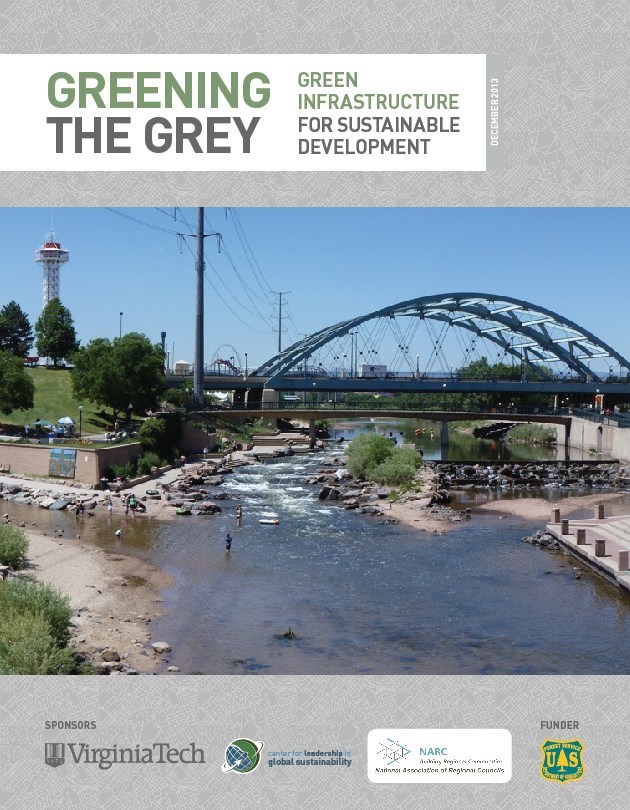Greening the Grey – Green Infrastructure for Sustainable Development
January 15, 2014
By: Courtney Kimmel
Infrastructure supports our lives and livelihoods. It manages our access to food, water, energy, transportation, communication, waste disposal, and other critical services. It provides the foundation on which our communities, economy, and security are built and thrive or falter. The strength and resilience of our infrastructure systems are directly correlated to the strength and resilience of the places we live, now and into an uncertain future. Most of us take the infrastructure, and its resilience, for granted – until something fails or the cost of repair becomes exorbitant.
“Grey” infrastructure has traditionally attracted the most attention – e.g., roads, power grids, piped sewer and water systems – but the “green” infrastructure, the natural systems and features that provide valuable ecosystem services, is just as critical. We need both to support resilient and vibrant places. In the past, these green infrastructure systems were often left out of the planning calculus, with the value of the services they supplied unaccounted for as a positive externality. But with mounting investments required to repair and maintain the aging stock of grey infrastructure systems, and increasing environmental pressures from expanding urbanization, the value of ecosystem services that have otherwise been “free” are entering more prominently into town, city, and regional planning and management equations. Compounded by increasing regulatory pressure to address water and air quality, the need to anticipate and adapt for localized (if yet uncertain) impacts of climate change, and the drive for economic competitiveness, all with ever more constricted finances, communities, cities, and regions across the US are increasingly assigning higher priority to their green infrastructure systems.
Green infrastructure is a concept that entered the sustainability discourse in the last decade among a wide range of agencies, organizations, companies, community groups, and planners. It elevates natural systems as infrastructure to a level of importance similar to “grey” systems and provides a common language for discussing these systems. But as is often the case when new organizing concepts emerge, its definition, application, and implication must be negotiated at all levels. Its role, function, and measures of effectiveness must be defined relative to other infrastructure systems; to the entities that regulate, build, operate, and maintain them; and, to the services they provide and the quantification or qualification of those services. As is true in most negotiation, some interests prevail over others. While green infrastructure is becoming a more mainstream element of city and regional planning discussions in the US, it is running the risk of being narrowly defined in a way that does not capture the full range and value of ecosystem services it provides.
In this report, we make the case that Green infrastructure is more than a bioswale or a green roof or a forested corridor – it’s a different way of thinking about infrastructure. Understood as a multi-scale network of ecological features and systems that provide multiple functions and benefits, it provides a systems approach to planning and development that recognizes the value of ecosystem services and strives to integrate and enhance those ecosystem services within our built environment. Green infrastructure is not limited to a particular type of technology or feature doing a specific job; it’s the result of a wide network of institutions, organization, agencies, businesses, and citizens bringing ecosystem services back into planning and development. It’s ultimately about people and organizations making that choice. Realizing green infrastructure’s full potential requires coordination and collaboration across multiple boundaries – political, jurisdictional, agency, organizational, sectoral, disciplinary, professional, to name just a few. The most significant challenge for advancing a robust and integrated form of green infrastructure may be one of leadership and collective action.
Planning and decision making for vibrant and environmentally sustainable communities requires a systems perspective that integrates green and grey infrastructure: watershed and stormwater management; hubs and corridors for automobile, bus, rail, bicycle, pedestrian, and wildlife “traffic”; efficient energy grids and mature tree canopies to reduce carbon footprints and minimize urban heat island effect; city and regional land use plans that account for wastesheds, habitat, open spaces, working landscapes, riparian corridors, and more. A robust infrastructure system that supports sustainable development is essential to national prosperity, personal and public health, community vitality, and economic competitiveness. Green infrastructure systems, in their most robust sense, are a critical element of sustainable development.
This 2013 report is one outcome of a multi-year project funded by the US Forest Service and completed in cooperation with the National Association of Regional Councils, with the goal of mapping and evaluating the support system for green infrastructure planning in the US – a system that has changed dramatically over the study period and continues to evolve. The primary audience for this study was originally the National Green Infrastructure Community of Practice, an entity that has since ceased activities. So, while the target audience has shifted, the purpose of the project and this report remains the same: to provide green infrastructure practitioners and sponsors with a valuable reflection on how the concept emerged, how it has evolved, and where it is heading. In fact, in the same month this preface was written, the EPA released a new strategic agenda for green infrastructure in the US (PDF), and the World Resources Institute released an extensive guide to natural infrastructure investment, both of which reflect many of the same observations and recommendations that emerged from this study.
To learn more about Green Infrastructure, visit www.greeningthegrey.org



